List of heads of state of Afghanistan
This article lists the heads of state of Afghanistan since the foundation of the first Afghan state, the Hotak Empire, in 1709.
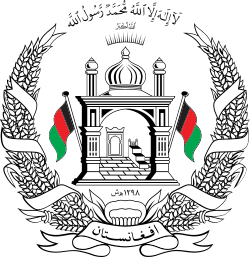 |
|---|
| This article is part of a series on the politics and government of Afghanistan |
|
Government Executive
Legislature
Judiciary |
|
Administrative divisions
|
|
|
The Hotak Empire was formed after a successful uprising led by Mirwais Hotak and other Afghan tribal chiefs from Kandahar against Mughal and Persian rule.[1][2][3]
After a long series of wars, the Hotak Empire was eventually replaced by the Durrani Afghan Empire that was founded by Ahmad Shah Durrani in 1747.[4][5]
After the collapse of the Durrani Empire in 1823, the Barakzai dynasty founded the Emirate of Afghanistan, transformed it into the Kingdom of Afghanistan in 1926, and ruled the country until the last King Mohammed Zahir Shah was deposed in the 1973 coup d'état, led by his first cousin Mohammed Daoud Khan. Despite being part of the Barakzai dynasty, Daoud Khan departed from tradition and did not proclaim himself Shah, instead abolished the monarchy and established the Republic of Afghanistan, with himself as President.[6][7] The Republic lasted until the Saur Revolution in 1978.
Since 1978, Afghanistan has been in a state of continuous internal conflict and foreign interventions.
The former president Hamid Karzai became the first ever democratically elected head of state of Afghanistan on 7 December 2004. The current president is Ashraf Ghani, since 29 September 2014.
List of heads of state
(Dates in italics indicate de facto continuation of office)
Monarchs
| Name | Portrait | Lifespan | Reign | Dynasty | ||
|---|---|---|---|---|---|---|
| Reign start | Reign end | Duration | ||||
| Hotak Empire (1709–1738) | ||||||
| Mirwais Hotak |  |
1673–1715 | 1709 | 1715 | 5–6 years | Hotak |
| Emir | ||||||
| Abdul Aziz Hotak |  |
Died 1717 | 1715 | 1717 | 1–2 years | Hotak |
| Emir; Brother of Mirwais Hotak | ||||||
| Mahmud Hotak |  |
1697–1725 | 1717 | 22 April 1725 | 7–8 years | Hotak |
| Emir; Son of Mirwais Hotak | ||||||
| Ashraf Hotak | 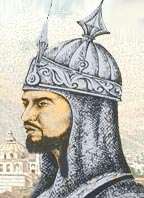 |
Died 1730 | 22 April 1725 | 1730 | 4–5 years | Hotak |
| Emir; Nephew of Mirwais Hotak | ||||||
| Hussain Hotak | 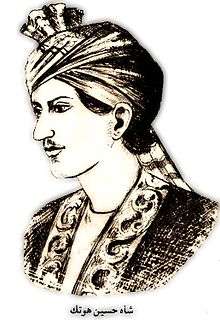 |
Died 1738 | 1730 | 24 March 1738 | 7–8 years | Hotak |
| Emir; Son of Mirwais Hotak | ||||||
| Afsharid Empire (1738–1747) | ||||||
| Nader Shah | .jpg) |
1688–1747 | 24 March 1738 | 19 June 1747 | 9 years, 78 days | Afsharid |
| Emir | ||||||
| Durrani Empire (1747–1823) | ||||||
| Ahmad Shah Durrani | 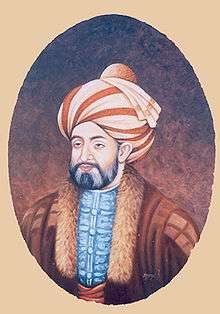 |
1722–1772 | October 1747 | 4 June 1772 | 24 years, 247 days | Durrani |
| Emir | ||||||
| Timur Shah Durrani | 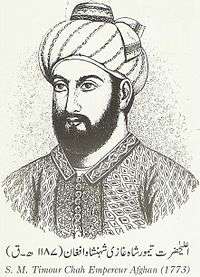 |
1748–1793 | 4 June 1772 | 18 May 1793 | 20 years, 348 days | Durrani |
| Emir; Son of Ahmad Shah Durrani | ||||||
| Zaman Shah Durrani | 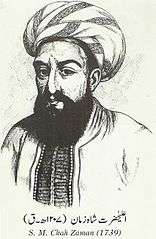 |
1770–1844 | 18 May 1793 | 25 July 1801 | 8 years, 68 days | Durrani |
| Emir; Son of Timur Shah Durrani; Deposed | ||||||
| Mahmud Shah Durrani | 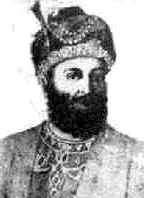 |
1769–1829 | 25 July 1801 | 13 July 1803 | 1 year, 353 days | Durrani |
| Emir; Son of Timur Shah Durrani; First Reign; Deposed | ||||||
| Shah Shujah Durrani | 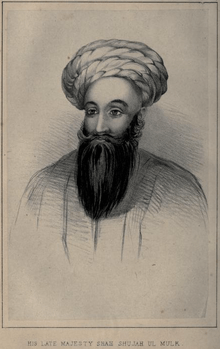 |
1785–1842 | 13 July 1803 | 3 May 1809 | 5 years, 294 days | Durrani |
| Emir; Son of Timur Shah Durrani; First Reign; Deposed | ||||||
| Mahmud Shah Durrani |  |
1769–1829 | 3 May 1809 | 1818 | 8–9 years | Durrani |
| Emir; Son of Timur Shah Durrani; Second Reign; Deposed | ||||||
| Ali Shah Durrani |  |
1818 | 1819 | 0–1 years | Durrani | |
| Emir; Son of Timur Shah Durrani; Deposed | ||||||
| Ayub Shah Durrani |  |
Died 1837 | 1819 | 1823 | 3–4 years | Durrani |
| Emir; Son of Timur Shah Durrani; Deposed | ||||||
| Emirate of Afghanistan (1823–1926) | ||||||
| Dost Mohammad Khan | 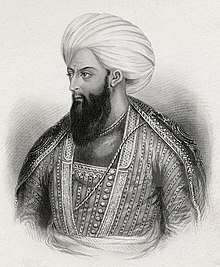 |
1793–1863 | 1823 | 2 August 1839 | 15–16 years | Barakzai |
| Emir; Son of Sardar Payenda Khan; First Reign; Exiled | ||||||
| Shah Shujah Durrani |  |
1785–1842 | 7 August 1839 | 5 April 1842 | 2 years, 241 days | Durrani |
| Emir; Son of Timur Shah Durrani; Second Reign; Assassinated following the 1842 retreat from Kabul | ||||||
| Wazir Akbar Khan | 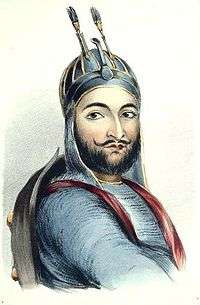 |
1816–1845 | 5 April 1842 | 1845 | 2–3 years | Barakzai |
| Emir; Son of Dost Mohammad Khan | ||||||
| Dost Mohammad Khan |  |
1793–1863 | 1845 | 9 June 1863 | 17–18 years | Barakzai |
| Emir; Son of Sardar Payenda Khan; Second Reign | ||||||
| Sher Ali Khan |  |
1825–1879 | 9 June 1863 | 1865 | 1–2 years | Barakzai |
| Emir; Son of Dost Mohammad Khan; First Reign; Deposed | ||||||
| Mohammad Afzal Khan |  |
1811–1867 | 1865 | 7 October 1867 | 1–2 years | Barakzai |
| Emir; Son of Dost Mohammad Khan | ||||||
| Mohammad Azam Khan | 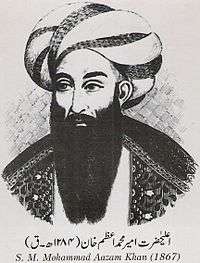 |
Died 1868 | 7 October 1867 | 21 February 1868 | 137 days | Barakzai |
| Emir; Son of Dost Mohammad Khan | ||||||
| Sher Ali Khan |  |
1825–1879 | 7 October 1868 | 21 February 1879 | 10 years, 137 days | Barakzai |
| Emir; Son of Dost Mohammad Khan; Second Reign | ||||||
| Mohammad Yaqub Khan | 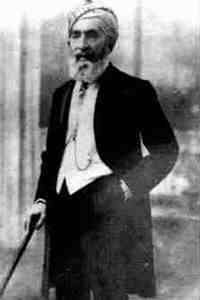 |
1849–1923 | 21 February 1879 | 12 October 1879 | 233 days | Barakzai |
| Emir; Son of Sher Ali Khan | ||||||
| Ayub Khan |  |
1857–1914 | 12 October 1879 | 31 May 1880 | 232 days | Barakzai |
| Emir; Son of Sher Ali Khan; Deposed | ||||||
| Abdur Rahman Khan | 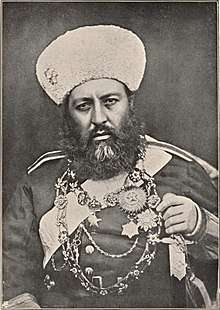 |
1840/1844–1901 | 31 May 1880 | 1 October 1901 | 21 years, 123 days | Barakzai |
| Emir; Son of Mohammad Afzal Khan | ||||||
| Habibullah Khan | 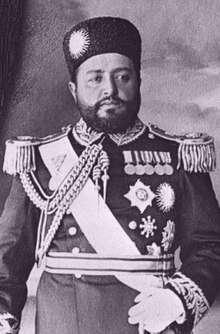 |
1872–1919 | 1 October 1901 | 20 February 1919 | 17 years, 142 days | Barakzai |
| Emir; Son of Abdur Rahman Khan; Assassinated | ||||||
| Nasrullah Khan |  |
1874–1920 | 21 February 1919 | 28 February 1919 | 7 days | Barakzai |
| Emir; Son of Abdur Rahman Khan; Deposed | ||||||
| Amanullah Khan |  |
1892–1960 | 28 February 1919 | 9 June 1926 | 7 years, 101 days | Barakzai |
| Emir; Son of Habibullah Khan | ||||||
| Kingdom of Afghanistan (1926–1973) | ||||||
| Amanullah Khan |  |
1892–1960 | 9 June 1926 | 14 January 1929 | 2 years, 219 days | Barakzai |
| King; Son of Habibullah Khan; Deposed | ||||||
| Inayatullah Khan |  |
1888–1946 | 14 January 1929 | 17 January 1929 | 3 days | Barakzai |
| King; Son of Habibullah Khan; Abdicated | ||||||
| Emirate of Afghanistan (1929) | ||||||
| Habibullāh Kalakāni | 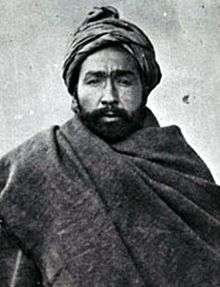 |
1891–1929 | 17 January 1929 [note 1] | 13 October 1929 | 269 days | Non-Dynastic |
| King and Emir [note 2]; Contested the throne during the 1928–29 civil war; Deposed and executed | ||||||
| Ali Ahmad Khan |  |
1883–1929 | 17 January 1929 | 9 February 1929 | 23 days | Non-Dynastic |
| King; Rose in opposition to Kalakāni during the 1928–29 civil war; Captured and executed | ||||||
| Amanullah Khan |  |
1892–1960 | March 1929 | 23 May 1929 | 83 days | Barakzai |
| King, Returned to Afghanistan to contest the throne during the 1928–29 civil war; Eventually retreated back into British India. | ||||||
| Kingdom of Afghanistan (1926–1973) | ||||||
| Mohammed Nadir Shah |  |
1883–1933 | 15 October 1929 | 8 November 1933 | 4 years, 24 days | Barakzai |
| King; Grandnephew of Dost Mohammed Khan; Assassinated by Abdul Khaliq Hazara | ||||||
| Mohammed Zahir Shah | 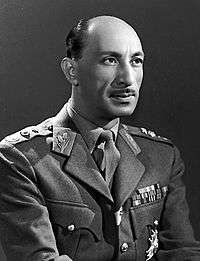 |
1914–2007 | 8 November 1933 | 17 July 1973 | 39 years, 251 days | Barakzai |
| King; Son of Mohammed Nadir Shah; Deposed | ||||||
Local monarchs
Some rulers tried to take advantage of internal conflicts in Afghanistan to claim the throne. However, their rule was limited only to certain areas.
| Name | Lifespan | Reign | Dynasty | ||
|---|---|---|---|---|---|
| Reign start | Reign end | Duration | |||
| Jehandad Khan | Died 1914 | May 1912 | c. 1 month | Non-dynastic | |
| Emir; Ruled only in Khost during the 1912 rebellion. | |||||
| Abd-al Karim | 1897–1927 | July 1924 | 30 January 1925 | 213 days | Barakzai |
| Emir; Son of Mohammad Yaqub Khan, rule limited to the Southern Province during the 1924–1925 rebellion. | |||||
| Salemai | Unknown | c. 1944 | c. 1946 | c. 2 years | Non-dynastic |
| King; rule limited to the Eastern Province during the 1944–47 tribal revolts. | |||||
Non-monarchs
| No | Portrait | Name
(Birth–Death) |
Term of office | Political party | |||
|---|---|---|---|---|---|---|---|
| Took office | Left office | Time in office | |||||
| Republic of Afghanistan (1973–1978) | |||||||
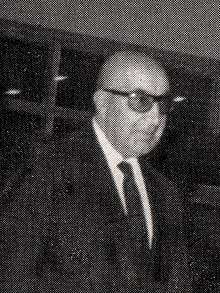 |
Mohammed Daoud Khan
(1909–1978) |
17 July 1973 | 28 April 1978 | 4 years, 285 days | Independent (until 1976) | ||
| National Revolutionary Party | |||||||
| President; Member of the Barakzai dynasty (first cousin of Mohammed Zahir Shah); Assassinated | |||||||
| Democratic (Communist) Republic of Afghanistan (1978–1992) | |||||||
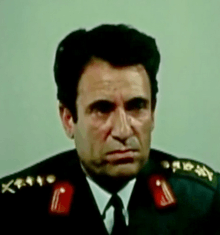 |
Colonel Abdul Qadir (1944–2014) |
28 April 1978 | 30 April 1978 | 2 days | People's Democratic Party (Khalq faction) | ||
| Chairman of the Presidium of the Military Revolutionary Council | |||||||
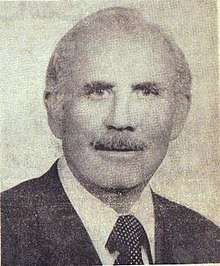 |
Nur Muhammad Taraki
(1917–1979) |
30 April 1978 | 14 September 1979 | 1 year, 137 days | People's Democratic Party (Khalq faction) | ||
| Chairman of the Presidium of the Revolutionary Council; Assassinated | |||||||
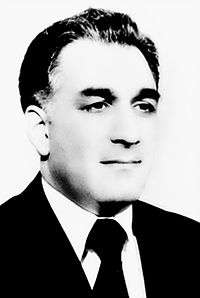 |
Hafizullah Amin
(1929–1979) |
14 September 1979 | 27 December 1979 | 104 days | People's Democratic Party (Khalq faction) | ||
| Chairman of the Presidium of the Revolutionary Council; Assassinated | |||||||
 |
Babrak Karmal
(1929–1996) |
27 December 1979 | 24 November 1986 | 6 years, 332 days | People's Democratic Party (Parcham faction) | ||
| Chairman of the Presidium of the Revolutionary Council; Dismissed | |||||||
 |
Haji Mohammad Chamkani
(1947–2012) |
24 November 1986 | 30 September 1987 | 310 days | Independent | ||
| Chairman of the Presidium of the Revolutionary Council; Appointed as part of National Reconciliation process | |||||||
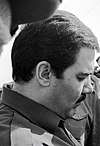 |
Mohammad Najibullah
(1947–1996) |
30 September 1987 | 16 April 1992 | 4 years, 199 days | People's Democratic Party (Parcham faction) (until 1990) | ||
| Homeland Party | |||||||
| President (Chairman of the Presidium of the Revolutionary Council until 30 November 1987); Resigned | |||||||
 |
Abdul Rahim Hatif
(1926–2013) |
16 April 1992 | 28 April 1992 | 12 days | Homeland Party | ||
| Acting President; Deposed | |||||||
| Islamic State of Afghanistan (1992–2002) | |||||||
 |
Sibghatullah Mojaddedi
(1925–2019) |
28 April 1992 | 28 June 1992 | 61 days | National Liberation Front | ||
| Acting President; Resigned | |||||||
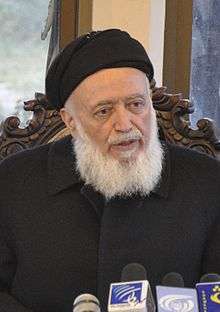 |
Burhanuddin Rabbani
(1940–2011) |
28 June 1992 | 22 December 2001 | 9 years, 167 days | Jamiat-e Islami | ||
| President; Between 1996 and 2001, the Islamic State remained the internationally recognized government, despite only controlling about 10% of Afghan territory | |||||||
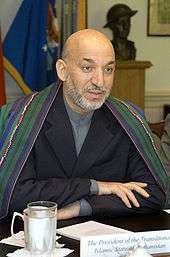 |
Hamid Karzai
(1957–) |
22 December 2001 | 13 July 2002 | 203 days | Independent | ||
| Acting President | |||||||
| Islamic Emirate of Afghanistan (1996–2001) | |||||||
 |
Mullah Mohammed Omar (1960–2013) |
27 September 1996 | 13 November 2001 | 5 years, 47 days | Taliban | ||
| Head of the Supreme Council; Emir and Commander of the Faithful; The Islamic Emirate never attained widespread international recognition, despite controlling about 90% of Afghan territory; Deposed | |||||||
 |
Mullah Mohammad Rabbani (1955–2001) |
27 September 1996 | 13 April 2001 | 4 years, 198 days | Taliban | ||
| Deputy Head of the Supreme Council; Prime Minister; Deputy leader of the Taliban; Died in office | |||||||
 |
Maulavi Abdul Kabir (1958/1963–) |
16 April 2001 | 13 November 2001 | 211 days | Taliban | ||
| Acting Deputy Head of the Supreme Council; Acting Prime Minister; Deposed | |||||||
| Transitional Islamic State of Afghanistan (2002–2004) | |||||||
 |
Hamid Karzai
(1957–) |
13 July 2002 | 7 December 2004 | 2 years, 147 days | Independent | ||
| Transitional President | |||||||
| Islamic Republic of Afghanistan (2004–present) | |||||||
 |
Hamid Karzai
(1957–) |
7 December 2004 | 29 September 2014 | 9 years, 296 days | Independent | ||
| President; First democratically elected head of state | |||||||
.jpg) |
Ashraf Ghani
(1949–) |
29 September 2014 | Incumbent | 5 years, 261 days | Independent | ||
| President; First peaceful transfer of power | |||||||
Standards of heads of state
.svg.png) Standard of the King of Afghanistan, 1931–1973.
Standard of the King of Afghanistan, 1931–1973..svg.png) Standard of the President of Afghanistan, 2004–2013.
Standard of the President of Afghanistan, 2004–2013. Standard of the President of Afghanistan, 2013–present.
Standard of the President of Afghanistan, 2013–present.
See also
Notes
References
- "An Outline Of The History Of Persia During The Last Two Centuries (A.D. 1722-1922)". Edward Granville Browne. London: Packard Humanities Institute. p. 29. Retrieved 2010-09-24.
- Otfinoski, Steven (2004). Afghanistan. Infobase Publishing. p. 7. ISBN 0-8160-5056-2. Retrieved 2010-09-27.
- Malleson, George Bruce (1878). History of Afghanistan, from the Earliest Period to the Outbreak of the War of 1878. London: Elibron.com. p. 227. ISBN 1-4021-7278-8. Retrieved 2010-09-27.
- "Afghanistan". The World Factbook. Central Intelligence Agency. Retrieved 2010-10-23.
Ahmad Shah DURRANI unified the Pashtun tribes and founded Afghanistan in 1747.
- "Last Afghan empire". Louis Dupree, Nancy Hatch Dupree and others. Encyclopædia Britannica Online Version. Retrieved 2010-09-24.
- "Afghan King Overthrown; A Republic Is Proclaimed". The New York Times. July 18, 1973. Retrieved May 3, 2020.
- Barfield, Thomas (March 25, 2012). Afghanistan: A Cultural and Political History (Princeton Studies in Muslim Politics). Princeton University Press. ISBN 978-0691154411.
- Qassem, Dr Ahmad Shayeq (2013-03-28). Afghanistan's Political Stability: A Dream Unrealised. Ashgate Publishing, Ltd. p. 175. ISBN 9781409499428.
- Wazir, Azmatullah Khan (2002). The immediate solution of Afghan crisis. A.K. Wazir. p. 8.
- Muḥammad, Fayz̤; McChesney, R. D. (1999). Kabul under siege: Fayz Muhammad's account of the 1929 Uprising. Markus Wiener Publishers. p. 37. ISBN 9781558761544.
- "ExecutedToday.com » 1929: Habibullah Kalakani, Tajik bandit-king". 1 November 2016. Retrieved 2019-11-14.
- Muḥammad, Fayz̤; Hazārah, Fayz̤ Muḥammad Kātib; Muḥammad, Faiḍ (1999). Kabul Under Siege: Fayz Muhammad's Account of the 1929 Uprising. Markus Wiener Publishers. p. 1. ISBN 978-1-55876-155-1.